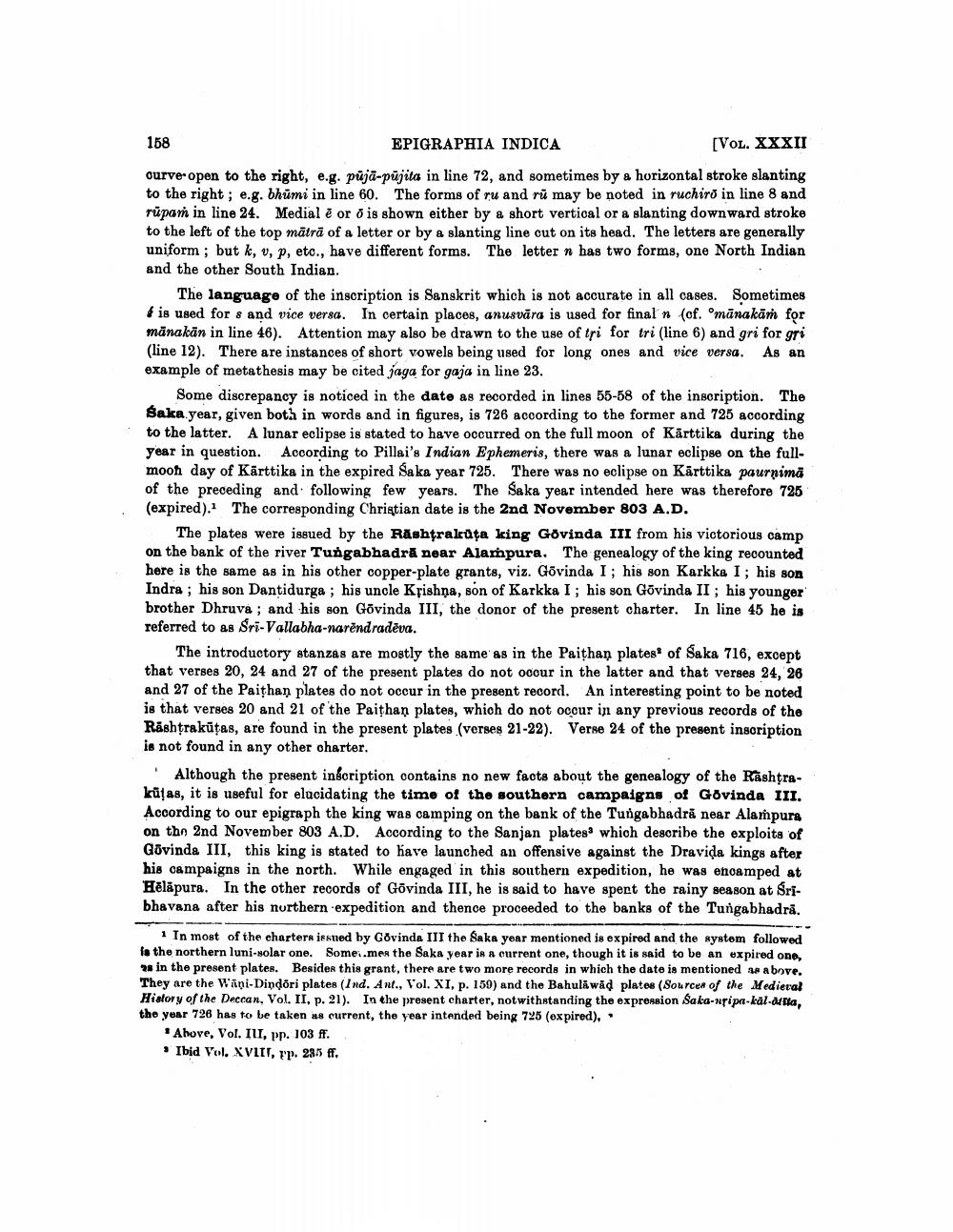________________
158
EPIGRAPHIA INDICA
[VOL. XXXII
curve-open to the right, e.g. pūjā-pūjita in line 72, and sometimes by a horizontal stroke slanting to the right; e.g. bhumi in line 60. The forms of ru and ru may be noted in ruchiro in line 8 and rupam in line 24. Medial è or ō is shown either by a short vertical or a slanting downward stroke to the left of the top matra of a letter or by a slanting line cut on its head. The letters are generally uniform; but k, v, p, etc., have different forms. The letter n has two forms, one North Indian and the other South Indian.
The language of the inscription is Sanskrit which is not accurate in all cases. Sometimes is used for s and vice versa. In certain places, anusvāra is used for final n (cf. mānakām for mānakān in line 46). Attention may also be drawn to the use of tri for tri (line 6) and gri for gri (line 12). There are instances of short vowels being used for long ones and vice versa. As an example of metathesis may be cited jaga for gaja in line 23.
Some discrepancy is noticed in the date as recorded in lines 55-58 of the inscription. The Saka year, given both in words and in figures, is 726 according to the former and 725 according to the latter. A lunar eclipse is stated to have occurred on the full moon of Karttika during the year in question. According to Pillai's Indian Ephemeris, there was a lunar eclipse on the fullmooh day of Karttika in the expired Saka year 725. There was no eclipse on Kārttika paurņimā of the preceding and following few years. The Saka year intended here was therefore 725 (expired). The corresponding Christian date is the 2nd November 803 A.D.
The plates were issued by the Rashtrakuta king Govinda III from his victorious camp on the bank of the river Tungabhadra near Alampura. The genealogy of the king recounted here is the same as in his other copper-plate grants, viz. Govinda I; his son Karkka I; his son Indra; his son Dantidurga; his uncle Krishna, son of Karkka I; his son Govinda II; his younger brother Dhruva; and his son Govinda III, the donor of the present charter. In line 45 he is referred to as Sri-Vallabha-narendradeva.
The introductory stanzas are mostly the same as in the Paithan plates of Saka 716, except that verses 20, 24 and 27 of the present plates do not occur in the latter and that verses 24, 26 and 27 of the Paithan plates do not occur in the present record. An interesting point to be noted is that verses 20 and 21 of the Paithan plates, which do not occur in any previous records of the Rashtrakutas, are found in the present plates (verses 21-22). Verse 24 of the present inscription is not found in any other charter.
Although the present inscription contains no new facts about the genealogy of the Rashtrakülas, it is useful for elucidating the time of the southern campaigns of Govinda III. According to our epigraph the king was camping on the bank of the Tungabhadra near Alampura on the 2nd November 803 A.D. According to the Sanjan plates which describe the exploits of Govinda III, this king is stated to have launched an offensive against the Dravida kings after his campaigns in the north. While engaged in this southern expedition, he was encamped at Hēlāpura. In the other records of Govinda III, he is said to have spent the rainy season at Sribhavana after his northern expedition and thence proceeded to the banks of the Tungabhadra.
1 In most of the charters issued by Govinda III the Saka year mentioned is expired and the system followed is the northern luni-solar one. Some..mes the Saka year is a current one, though it is said to be an expired one, 28 in the present plates. Besides this grant, there are two more records in which the date is mentioned as above. They are the Wani-Dindori plates (Ind. Ant., Vol. XI, p. 159) and the Bahulawad plates (Sources of the Medieval History of the Deccan, Vol. II, p. 21). In the present charter, notwithstanding the expression Saka-nripa-kal-atta, the year 726 has to be taken as current, the year intended being 725 (expired),
Above, Vol. III, pp. 103 ff.
Ibid Vol. XVIII, pp. 235 ff.




